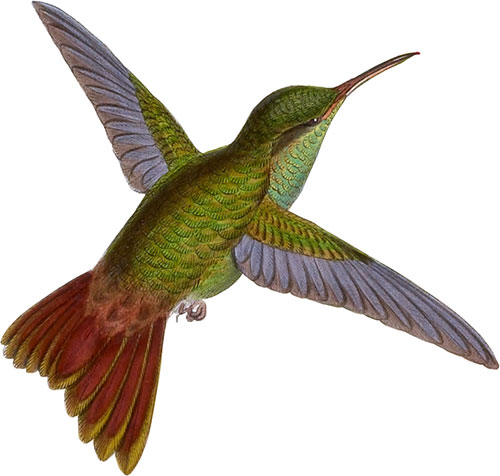Fawn-breasted Amazili
Mexico. In the neighbourhood of Cordova, according to M. Sallé.
The Humming-bird figured on the accompanying Plate is a species very recently discovered by M. Salle at Cordova in Mexico.
It differs sufficiently from every other to satisfy the most scrupulous as to its distinctness. Less difference occurs in the colouring of the sexes than is observable in most other species, but in this particular it accords with the other members of the genus. Two of the three specimens procured by M. Salle, all of which now form part of my own collection, are said to be males and the third a female; the latter being principally distinguished from the former by the indistinct mark of blackish-brown near the tips of four of the tail-feathers, namely the two on each side next the middle ones.
The tips of all the tail-feathers of both sexes are fringed with a bronzy-orange, which is more intense on the middle than on the outer ones, where indeed it becomes almost obsolete.
This species is about the size of A. Riefferi; but its bill is less robust, and the chestnut colouring of the tail-feathers is of a somewhat lighter hue; as also are the under tail-coverts.
Head, all the upper surface, wing- and upper tail-coverts bronzy-green; wings purplish-brown; tail dark chestnut-red, each feather narrowly bordered and tipped with a bronzy lustre, which is of greatest extent and most conspicuous on the two centre tail-feathers; throat and chest luminous green; under surface of the shoulder and flanks dull green; abdomen and under tail-coverts fawn-colour; thighs white; bill reddish-flesh or yellow, at the base merging into brown, and tipped with black.
The Plate represents two males and a female. The plant is the Gonolobus Martianus.
 Amazilia corallirostris
Coral-billed Amazili
Amazilia corallirostris
Coral-billed Amazili
 Amazilia Yucatanensis
Yucatan Amazili
Amazilia Yucatanensis
Yucatan Amazili
 Amazilia castaneiventris
Chestnut-bellied Amazili
Amazilia castaneiventris
Chestnut-bellied Amazili
 Amazilia Riefferia
Rieffer’s Amazili
Amazilia Riefferia
Rieffer’s Amazili
 Amazilia beryllina
Berylline Amazili
Amazilia beryllina
Berylline Amazili
 Amazilia Devillei
Deville’s Amazili
Amazilia Devillei
Deville’s Amazili
 Amazilia viridigaster
Green-bellied Amazili
Amazilia viridigaster
Green-bellied Amazili
 Amazilia cyanura
Blue-tailed Amazili
Amazilia cyanura
Blue-tailed Amazili
Featuring all 422 illustrated species from John Gould’s A Monograph of the Trochilidæ, or Family of Humming-Birds arranged by color.